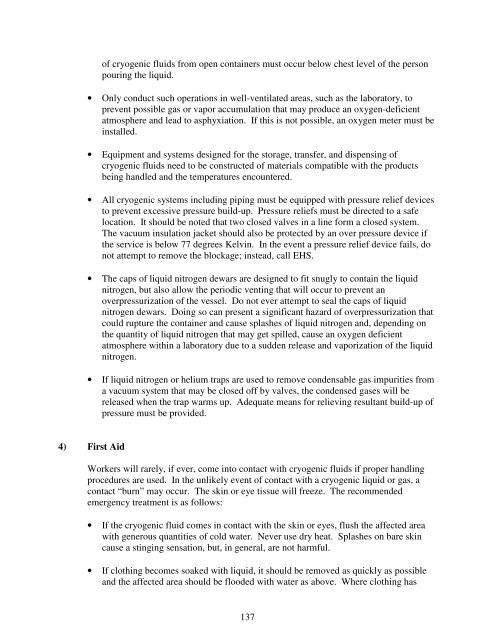Chemical Hygiene Plan - Queensborough Community College ...
Chemical Hygiene Plan - Queensborough Community College ...
Chemical Hygiene Plan - Queensborough Community College ...
You also want an ePaper? Increase the reach of your titles
YUMPU automatically turns print PDFs into web optimized ePapers that Google loves.
of cryogenic fluids from open containers must occur below chest level of the person<br />
pouring the liquid.<br />
• Only conduct such operations in well-ventilated areas, such as the laboratory, to<br />
prevent possible gas or vapor accumulation that may produce an oxygen-deficient<br />
atmosphere and lead to asphyxiation. If this is not possible, an oxygen meter must be<br />
installed.<br />
• Equipment and systems designed for the storage, transfer, and dispensing of<br />
cryogenic fluids need to be constructed of materials compatible with the products<br />
being handled and the temperatures encountered.<br />
• All cryogenic systems including piping must be equipped with pressure relief devices<br />
to prevent excessive pressure build-up. Pressure reliefs must be directed to a safe<br />
location. It should be noted that two closed valves in a line form a closed system.<br />
The vacuum insulation jacket should also be protected by an over pressure device if<br />
the service is below 77 degrees Kelvin. In the event a pressure relief device fails, do<br />
not attempt to remove the blockage; instead, call EHS.<br />
• The caps of liquid nitrogen dewars are designed to fit snugly to contain the liquid<br />
nitrogen, but also allow the periodic venting that will occur to prevent an<br />
overpressurization of the vessel. Do not ever attempt to seal the caps of liquid<br />
nitrogen dewars. Doing so can present a significant hazard of overpressurization that<br />
could rupture the container and cause splashes of liquid nitrogen and, depending on<br />
the quantity of liquid nitrogen that may get spilled, cause an oxygen deficient<br />
atmosphere within a laboratory due to a sudden release and vaporization of the liquid<br />
nitrogen.<br />
• If liquid nitrogen or helium traps are used to remove condensable gas impurities from<br />
a vacuum system that may be closed off by valves, the condensed gases will be<br />
released when the trap warms up. Adequate means for relieving resultant build-up of<br />
pressure must be provided.<br />
4) First Aid<br />
Workers will rarely, if ever, come into contact with cryogenic fluids if proper handling<br />
procedures are used. In the unlikely event of contact with a cryogenic liquid or gas, a<br />
contact “burn” may occur. The skin or eye tissue will freeze. The recommended<br />
emergency treatment is as follows:<br />
• If the cryogenic fluid comes in contact with the skin or eyes, flush the affected area<br />
with generous quantities of cold water. Never use dry heat. Splashes on bare skin<br />
cause a stinging sensation, but, in general, are not harmful.<br />
• If clothing becomes soaked with liquid, it should be removed as quickly as possible<br />
and the affected area should be flooded with water as above. Where clothing has<br />
137
















